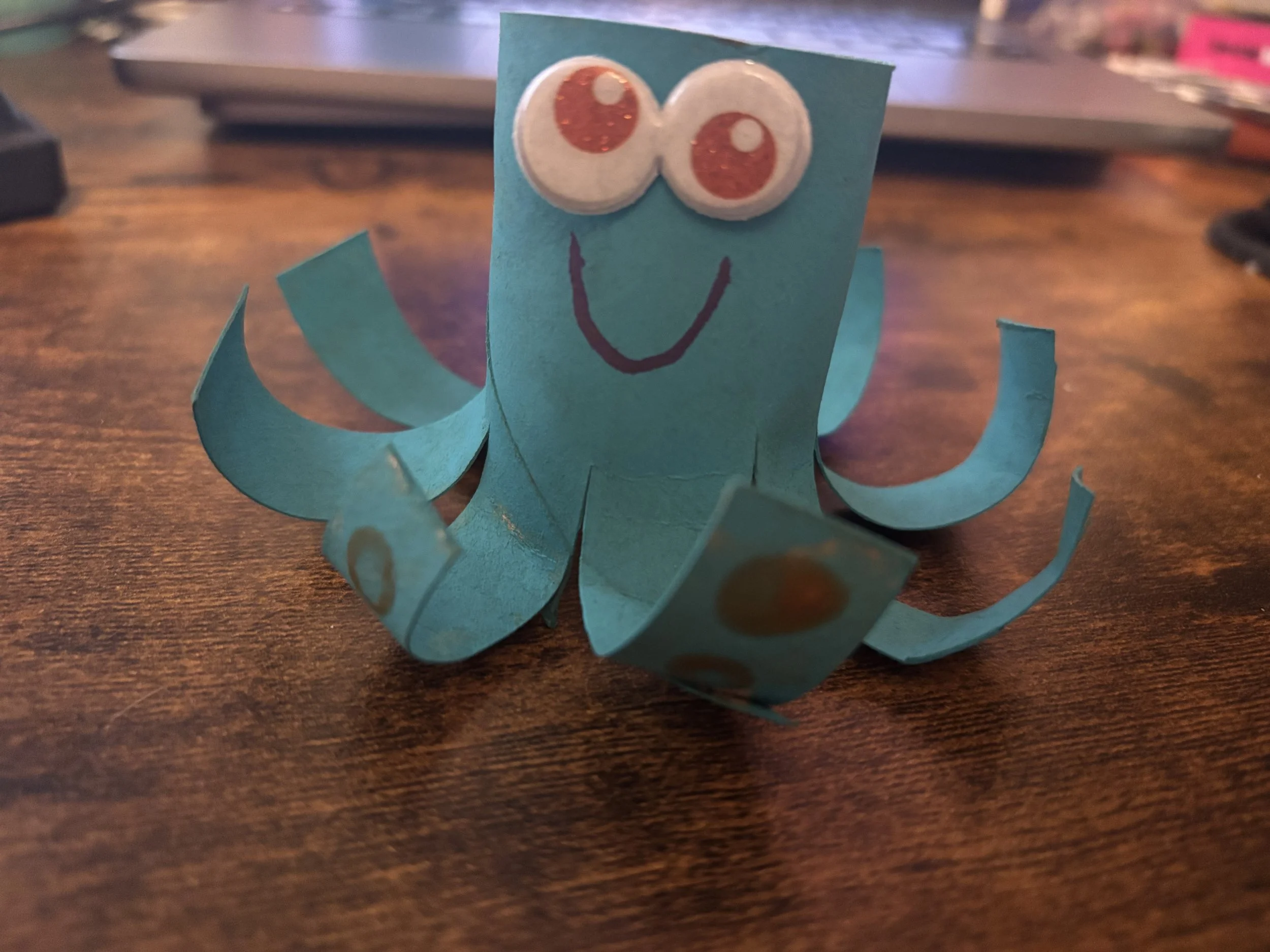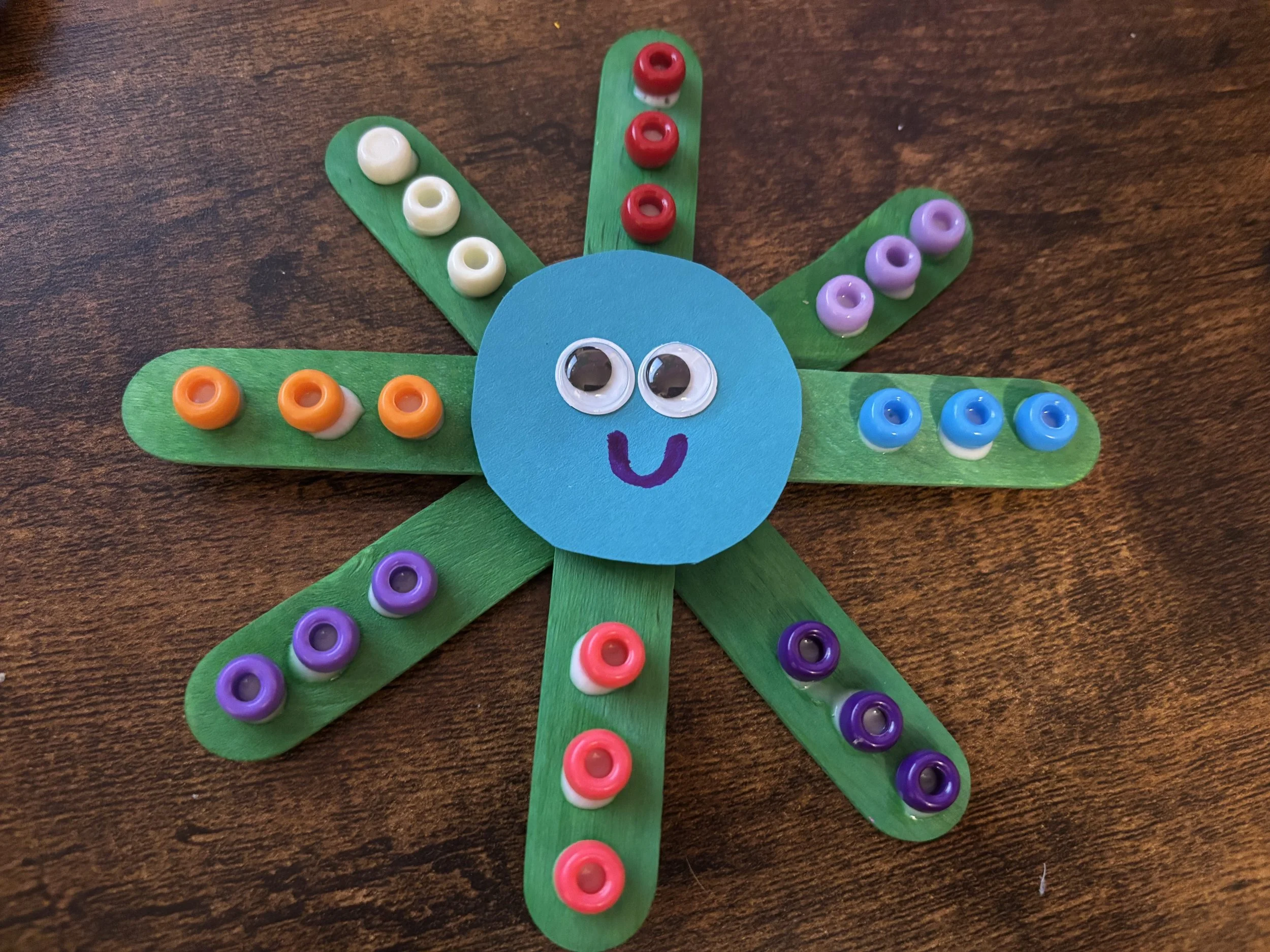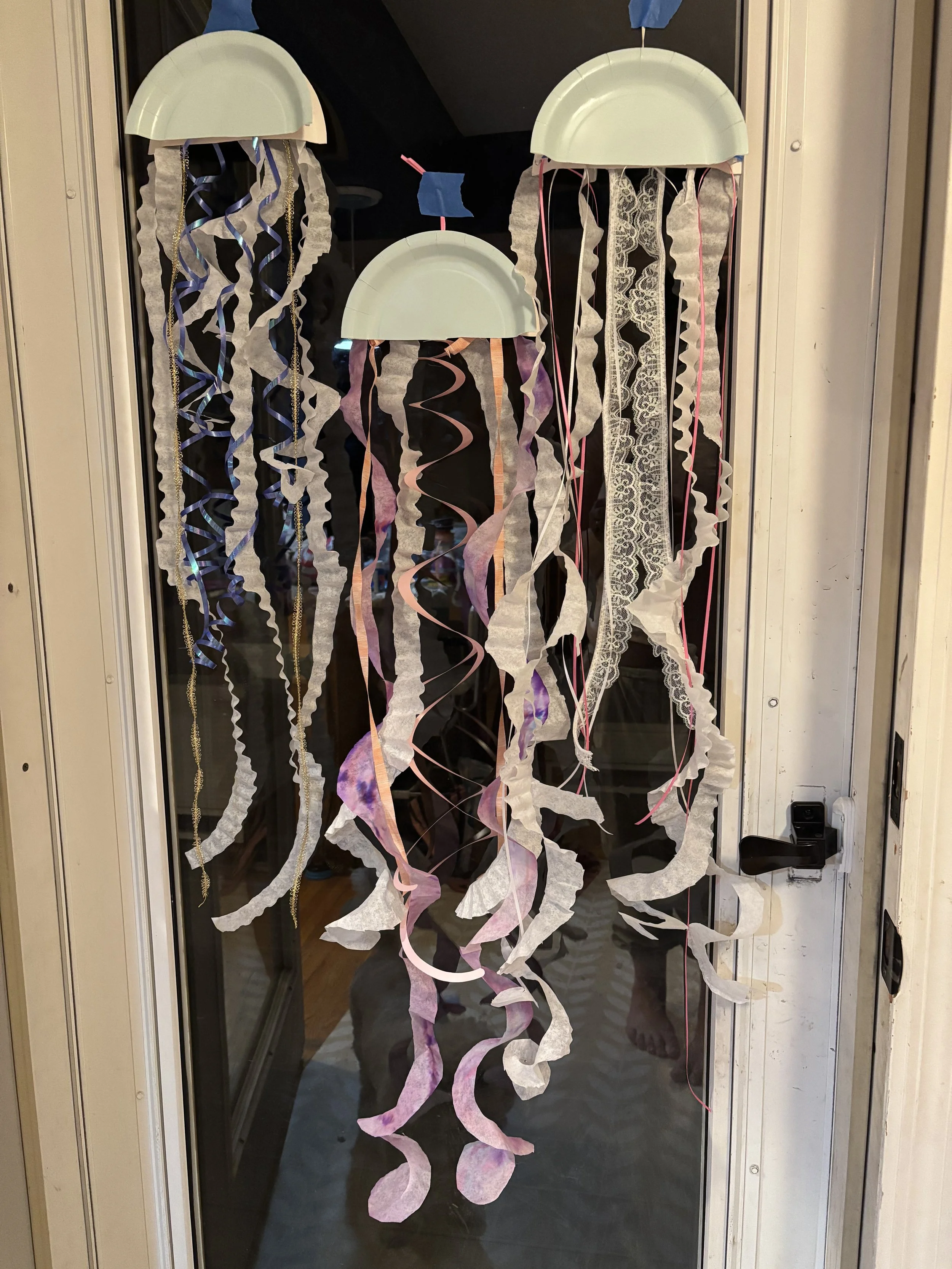Play like an Octopus: Creative Ocean Activities Using Household Supplies
Did you know that mimic octopuses can pretend to be jellyfish, crabs, and other sea creatures? These amazing animals change their shape and color to look like totally different ocean friends. Just like mimic octopuses, kids can use their imagination to transform everyday supplies into incredible ocean crafts.
Here is the most amazing part. Mimic octopuses do not learn their clever tricks from their parents. Both parents die before the babies even hatch. Every mimic octopus figures out how to transform and adapt completely on its own through experimentation and practice.
Sound familiar? Kids are natural experimenters, too. When we give them space to explore, make choices, and figure things out independently, they discover abilities we never knew they had.
Why Octopus Crafts Are Perfect for Independent Play
Octopus crafts give kids the chance to think, create, and problem-solve on their own. When children lead their own creative projects, they build critical thinking skills and confidence. They learn to make choices, try new ideas, and figure things out without waiting for grown-ups to tell them what to do.
Ocean crafts like octopuses are especially great because kids already love sea creatures. The ocean is full of mystery and wonder. When kids make their own octopus, they get to explore colors, textures, and shapes while learning about these amazing, intelligent animals.
Best of all, octopus crafts use supplies families already have at home. No expensive kits. No special trips to the store. Just creativity and household materials.
Play like a Mimic Octopus: Five Ocean Creature Crafts to Make and Play With
A mimic octopus can transform into a jellyfish, a crab, and more. Now your kids can transform everyday objects into those sea creatures! Try making all five of these ocean crafts to see how many different creatures you can create.
Recommended Age: 3 - 8
Time: 30-40 minutes (with drying)
Author: GlueStick
Toilet paper tubes are one of our favorite craft supplies here at GlueStick, and this octopus craft does not disappoint. Paint the roll, cut strips at the bottom for legs, and bend them to make the octopus stand up. Add a face and decorations.
Why Toilet Paper Tube Octopuses are awesome: This craft teaches kids that everyday items can become something new. It shows them how to see possibilities in things we might throw away. That is creative thinking and sustainability in action, and it makes a fun toy to play with when you’re done!
Recommended Age: 5+
Time: 40-60 minutes for a medium to large batch, plus time to cool
Author: A Little Pinch of Perfect
Turn a fluffy marshmallow into an adorable octopus with wiggly pipe cleaner tentacles. Kids can twist and bend the pipe cleaners to make their octopus move and pose. Add googly eyes and watch your octopus come to life.
What makes Marshmallow and Pretzel Rod Octopuses great for kids: This craft is going to take a little trial and error to get just right. How hot is hot enough for the candy melt? How far apart do the pretzel rods need to be? Can you work fast enough to get the face to stick? Kids might not get this one right on their first try, and that’s ok. A mimic octopus’s impressions aren’t perfect either, but they’re still good enough to fool a hungry predator. This craft is a delicious reminder to keep trying and experimenting until you have something you’re really proud of.
Recommended Age: 3-7
Time: 20-40 minutes, plus time to dry
Author: GlueStick
Popsicle sticks become colorful octopus tentacles in this fun craft. Kids can paint the sticks any color they want or use pre-colored sticks for less mess, then arrange them in a fan shape. Add pony bead suckers, a circle for the head and googly eyes. Every octopus looks different because every kid makes their own creative choices.
How Craft Stick Octopuses Create Kids as Smart as Real Octopuses: This project encourages kids to practice patterns, symmetry, and colors. They decide how to arrange the tentacles and what colors to use. These are math and design skills hidden inside a fun project.
Paper Plate Jellyfish
(One of the creatures a mimic octopus pretends to be!)
Recommended Age: 5+
Time: 15-30 minutes
Author: GlueStick
Transform a paper plate into a floating jellyfish with flowing tentacles. Kids can choose their own streamers or ribbon for tentacles and decorate their jellyfish however they imagine. Hang it from the ceiling and watch it drift like a real jellyfish in the ocean.
Why Paper Plate Jellyfish reinforce STEAM learning: Kids explore movement and texture. They see how different materials create different effects. Ribbon flows differently than yarn. Tissue paper looks different than streamers. These are science observations happening through art and are the same kinds of observations the. mimic octopus makes when it’s experimenting to see how to mimic a jellyfish’s movements and colors.
Paper Cup Crab
(Another creature a mimic octopus pretends to be!)
Recommended Age: 7+
Time: 15-30 minutes
Author: GlueStick
Turn a small paper cup into a silly crab with googly eyes and paper legs. Kids can make their crab walk sideways just like real crabs do. They can add claws, patterns, and personality. Some kids make friendly crabs. Others make grumpy ones. All of them are perfect.
How Paper Cup Crabs Teach Kids Patience and Play: Kids learn about how crabs move and look. They practice poking holes and bending pipe cleaners. They make choices about claw size and leg placement. This is engineering and biology mixed with creativity, and when they’re done, they can use their little crabs to play pretend with all their other ocean critters!
Tips for Parents: Let Kids Lead the Creative Journey
The best part of these sea creature crafts is watching kids take charge. Here is how to support independent creativity without taking over:
Set up, then step back. Put supplies where kids can reach them. Show them the basic idea if needed, then let them explore on their own. Just like the mimic octopus learns through trial and error, kids need space to try things their own way.
Ask questions instead of giving directions. Try "What color do you think your octopus should be?" instead of "Make it blue." Questions help kids think through their own ideas.
Celebrate the process, not perfection. The goal is not a perfect project. The goal is a child who feels confident trying new things and making their own choices.
Let them problem solve. If something does not work the first time, resist the urge to fix it. Ask "What else could you try?" Kids learn more from figuring things out than from having adults solve problems for them.
Embrace the mess. Creativity is messy. That is okay. Set up in an easy-to-clean space and let kids explore without worry. Then, let GlueStick’s clean up scavenger hunt encourage THEM to help you put all the supplies away when they’re done.
From Setup to Cleanup: Supporting Independent Creativity
Real independence means kids can handle the whole project—not just the fun middle part. Here is how to support the full creative journey:
Setup: Keep craft supplies organized in bins or baskets kids can access. Label them with pictures if kids cannot read yet. When children can gather their own supplies, they feel capable and ready to create.
Creation: Give kids space and time. Some children work fast. Others take their time. Both are fine. Avoid hovering or offering too much help unless they ask.
Cleanup: Make cleanup part of the creative process, not a punishment. Use a timer and make it a game. Play music. Work together at first, then gradually let kids take more responsibility. Cleanup teaches kids that creativity includes taking care of supplies and spaces.
Why Ocean Crafts Build More Than Art Skills
When kids make octopus crafts, they learn about ocean animals and habitats. They practice fine motor skills like cutting and gluing that are important for learning to write. They make decisions about colors, shapes, and designs. They solve problems when something does not work the way they expected.
These are STEM skills—science, technology, engineering, and math—hidden inside a fun craft project. Kids do not know they are learning. They just know they are creating something cool.
Ocean crafts also open the door to bigger questions. How many arms does an octopus really have? Where do octopuses live? What do they eat? Creativity leads to curiosity. Curiosity leads to learning.
More Independent Craft Ideas for Kids
If your child loves octopus crafts, they will love exploring more ocean projects and other creative activities. The GlueStick app guides kids through hundreds of projects using supplies you already have at home.
GlueStick is different from other craft apps. It is made for kids to use independently. Children pick projects based on what supplies they have. They follow step-by-step instructions made just for them. They even go on scavenger hunts to find supplies around the house.
No ads. No expensive kits. No parent-directed activities. Just kids leading their own creative journey from setup to cleanup.
Ready to inspire your child's creativity? Download GlueStick today and unlock hundreds of independent craft ideas that build confidence, critical thinking, and creativity—one project at a time.
Looking for more ocean crafts?
Want even more ocean fun? Check out our post Dive into Summer Fun: 9 Ocean-Themed Crafts That Make Waves with Kids for additional sea creature projects your family will love.







